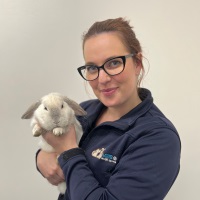
Sydney, 9 - 10 September 2026
Schedule
Create your personal agenda –check the favourite icon
An innovative model for veterinary disaster response
Disasters are increasing in scale and frequency. Gaps in access to veterinary care and veterinary professional shortages also create a disaster of their own. When those two problems intersect, communities and families with pets and livestock are devastated. The California Veterinary Emergency Team (CVET) is a pioneering disaster response program. Based at the University of California, Davis’ School of Veterinary Medicine, CVET’s mission is to lead collaborative veterinary response during disasters. This session will explore the challenges of disaster preparedness and response for animals across California. Additionally, the talk will highlight real-world examples of outreach, planning, and exercises that strengthen community resilience and mitigate common challenges. Finally, presentation will include insight into CVET’s innovative model of an established, scalable approach for delivering coordinated veterinary care during emergencies.
Chair
Clinical
VetTech
Elanco
Therian
Technology
Pancreatitis in Dogs: Practical Strategies for Diagnosis and Management
- Optimizing diagnosis of pancreatitis – when is a full clinical diagnosis needed and when can we get away with fewer tests?
- New evidenced based recommendations for management of pancreatitis in dogs
- Innovative therapies: fuzapladib sodium, mesenchymal stem cells, corticosteroids
Introducing the Burnout Barometer: A New Tool to Support Veterinary Nurse Wellbeing
Burnout is a growing concern across veterinary teams, yet most support strategies focus on individual coping rather than systemic change. This session introduces a new workplace-based survey tool designed specifically to help veterinary nurse leaders identify and address burnout within their teams - before it escalates. Developed from research into the key drivers of burnout, the tool helps to identify key drivers of veterinary nurse burnout in their early stages, and guides selection of tailored strategies to reduce burnout, and improve wellbeing within teams.
Presentation
Practice Management
Technology
Picking the right diet for the chronic enteropathy dog
- Review the cuases of chronic enteropathy
- Localizing diarrhea
- Diagnostic approach and rule outs
- How to use low cost and history information to pick the right diet the first time
So, you want to be a VTS?
What the VTS really is; are you ready?; the application simplified; studying without burning out; what to expect for exams; after the letters, what's ne
Anesthesia & Pain Management
Practice Owner
Mastering Radiographic Imaging Using PALACE Approach
- - Positioning
- Why positioning is everything for diagnostic quality
- Key directional terms + quick landmark checks
- Common positioning mistakes (and how to fix them fast)
A - Alignment
- Ensuring the area of interest is centred and straight
- Avoiding rotation: quick visual cues before you shoot
- Tricks for aligning challenging patients (painful, fractious, obese)
L - Labeling
- Correct side markers: why they matter medicolegally
- Preventing mix-ups in multi-view or multi-patient imaging
- Digital vs physical markers — when each works best
A - Artefacts
- Rapid identification of the most common artefacts
- Patient, equipment, and handler artefacts: how to troubleshoot
- Quick fixes before repeating the shot
C - Collimation
- Radiation safety + image clarity benefits
- How to judge correct collimation quickly
- Avoiding cut-off anatomy and unnecessary retakes
E - Exposure
- Fast approach to choosing correct exposure settings
- Recognising overexposure vs underexposure at a glance
- Adjustments you can make without re-positioning
Putting PALACE Into Practice
- Live walk-through of a case using PALACE
- How to mentally run the checklist in <10 seconds
- Building muscle memory for consistently diagnostic images
Tips on managing the atopic dog
Animal Trauma Triage Scoring
- What is the Animal Trauma Triage scoring, when to use and how.
- What are the benefits of using it?
- What does this mean for the patient?
Antech
GapOnly®
Calm in the Consult Room: Behaviour-Based Strategies for Low-Stress Vet Visit
● Beginning the consult before the dog walks in how to set the dog up for success evenbefore the consult starts● What the role of the guardian is in the consult room and how they can influence thedog’s behaviour● How to read stress early – and respond before things go wrong● Choice helps dogs relax – how to give the dog some choice, even in a busy clinic● Post visit – “stress hangovers” and what guardians can do to set their dog up for successnext time.
Sink or Swim; High Volume Shelter Patient Management for the Veterinary Nurse
This presentation will introduce techniques and protocols for efficient management of animals and patients in a high volume shelter environment. It will include discussions about intake, disease and injury identification, animal movement for health, quarantine and illness protocol, medical treatments and recovery, shortening length of stay, behavior management and decompression techniques, and population health.
PATHOLOGY: Lymphoma on cytology: what your pathologist can (and can’t) tell you
The transformational power of intentional communication and relationship-centered care in Veterinary practice
Building trust and relationships within veterinary teams and with veterinary clients has never been more critical. Effective, relationship-centered communication can support the engagement of veterinary teams, the occupational wellness of veterinary professionals, and the sustainable health of veterinary businesses. This presentation will explore common communication challenges and their impacts and then build awareness and skills around intentional communication, active listening, empathy in communication, and relationship-building techniques.
Fostering a culture of trust, respect, and healthy interactions between colleagues and with clients enhances professional satisfaction and quality of care provided to veterinary patients honoring the human-animal bond.
Learning Objectives:
· Clarifying communication challenges and barriers and understanding the impacts
· Build knowledge and understand techniques that fortify effective, intentional communication
· Explore the elements and strategies of relationship-centered care and communication that can foster trust and support patient care in veterinary practice environments.
How AI is Changing the Way Pet Owners Search for Veterinary Services
How AI is Changing the Way Pet Owners Search for Veterinary Services
Why adapting now keeps your clinic visible.
AI tools like Google’s Search Generative Experience and ChatGPT are reshaping how pet owners find and choose veterinary services. These platforms don’t just list websites - they generate answers, and that changes what it takes for a clinic to be seen and chosen online.
In this session, veterinary marketing expert and former practice owner Deb Croucher unpacks how AI search is already influencing pet owner behaviour - and what that means for the visibility, growth, and sustainability of veterinary practices.
This session is relevant not only to general and specialist vets, but also to industry partners, including educational providers, diagnostics companies, and suppliers who want to understand better how digital behaviours are changing across the veterinary landscape.
Deb and the Specialist Vet Marketing team work with both clinics and industry partners to develop and deliver tailored marketing strategies that align with their goals. The result is stronger connections, increased engagement, and measurable growth across the veterinary profession.
Key Takeaways:
- How AI tools like ChatGPT and Google SGE are changing the search experience
- What these changes mean for veterinary practices, both general and specialist
- Why visibility in AI-generated answers matters for client acquisition
- How clinics and industry partners can respond with smart, measurable marketing strategies
It’s Not Kennel Cough; Canine Infectious Respiratory Disease Complex (CIRDC)
This presentation will introduce and deep dive into CIRDC with the different components and variables that make up the complex. It will include disease identification and prevention, treatment options and strategies for varying severities, resistant infections, coinfections, lab testing and recovery
Rewiring Recovery: The Nurse’s Guide to Neurorehabilitation
Neurological injury recovery in animals doesn’t end at diagnosis or surgery — ongoing, structured rehabilitation is essential for restoring function, preventing complications, and improving quality of life. Veterinary nurses are central to this process, providing hands-on care, monitoring progress, and guiding owners.
This lecture will cover the science of neuroplasticity and how targeted, repetitive exercises strengthen neural pathways. We will review common neurological conditions, prognosis factors, and practical starting points, including assessment of reflexes, management of abnormal muscle tone, and the importance of following the Neurodevelopmental Sequence. Practical techniques and safe progression to advanced exercises will be discussed alongside assistive devices, home modifications, and early mobilisation principles.
We will also address toileting challenges, monitoring strategies, red flags for reassessment, and effective client communication to enhance compliance and outcomes. Real-life case studies will illustrate how a stepwise, stability-before-mobility approach supports recovery in a variety of patients.
PATHOLOGY: Effusions in practice: what to do in-house (and when to send out)
Panel 5 Ps of Practice Evoke
Panel 5 Ps of Practice Evoke
Technology
Managing Indolent ulcers in Dogs and Cats
Navigating Client Grief: Gentle Tools to Support Pet Owners and Animal Care Professionals
- Compassionate tools to help veterinary teams bring comfort to grieving clients.
- Gentle communication approaches for emotionally sensitive moments.
- Strategies to support the emotional wellbeing of veterinary professionals.
- Adaptable ideas that each practice can tailor to their own environment and needs.
Non-Amputation Pathways for Osteosarcoma: Integration of Systemic Therapy, RT and Palliative Protocols
-Management of Unresectable Canine Osteosarcoma.
Evaluating SRT and Chemotherapy vs. Surgical Standards.
Case Selection and considerations.
Limb Sparing Stereotactic Radiotherapy (RT process from diagnostic CT Simulation to Treatment)
Comparing Amputation to Advanced Stereo RT-Driven Management of Large-Breed Osteosarcoma.
-Palliative Radiotherapy.
Same day, immediate treatment with parallel opposed pair RT.
rapid pain relief.
Fuctional and quality of life outcomes.
-Case driven insights.
Practice Management
Technology
PetCann
“Sorry, it ate what?” Toxicities, Poisons and Emesis
Understanding diagnostic tests for coagulopathie
Mast Cell Tumour Hacks: Practical Tips & Tricks Beyond Surgery
Introduction on which types of MCTs should raise the index of concern
High grade
Insufficient margins (when are 'narrow' margins really too narrow)
Location e.g. mucous membranes, scrotum, snout, and multiple MCTs
Non-surgical strategies
Pre-treatment with anti-histamines and Prednisolone
Stelfonta
Radiation therapy
Chemotherapy
Palladia
The decision making process - how to pick from these techniques, and how to combine them
3-5 real world case examples who have had a combination of techniques above
Practice Management
Technology
Therian
Clinical
Taking the Perfect Orthopaedic Radiograph, An advanced approach to Capnography, Pain Physiology & Pharmacology for Veterinary Nurses
Rehabilitation
Scale Up
Heidi
Oncology 1
Therapeutic Benefits of Seaweed Extracts in Wound Healing
From Scrub Sink to Startups and Side Gigs: Vet Techs, Nurses, and Vets as Business Owners – my journey and challenges
Technology
Oncology 1 Mast Cell Tumours Unveiled: Diagnosis, Management & Species-Specific Insights for Dogs and Cats
Pain scales
Veterinary Medicine Woman
Caring for the carers
Medical Laser Therapy (MLT) : Focusing on the Science, not the Spin
- The Scientific basis of Medical Laser Therapy/Photobiomodulation( PBM)
- Literature Review: Ditch the Spin and Stay with the Science
- Understanding the ‘Drug-equivalent’ therapy aspect of MlT-PBM
Mast Cell Tumours Unveiled: Diagnosis, Management & Species-Specific Insights for Dogs and Cats
Panel
Panel: Social Justice
presentation
Technology
Create your personal agenda –check the favourite icon
Access to care in Veterinary Medicine: Current understanding and building moral resiliency in veterinary teams
Access to veterinary care refers to the ability of individuals to obtain necessary health services for animals in their care, companion or otherwise. Barriers to care encompass not just financial aspects, but also factors like geographic location, availability of services, and cultural competence of healthcare providers. Moral distress occurs when healthcare professionals know the ethically appropriate action to take but are constrained from taking it, leading to emotional and psychological stress. In veterinary medicine these scenarios may be a direct result of inadequate access to care.
During this presentation we will explore these connections as we understand it in the profession currently, but also to look at how individuals and teams can address these scenarios to work towards improved occupational wellness and build moral resiliency.
Topics discussed will include reframing team approaches to the spectrum of care, palliative care and humane euthanasia as strategies for improving animal welfare as well as Self-Care and Professional Support.
We will also explore resources that can be implemented by teams to provide support for different barriers to care including: financial flexibility, language accommodations, and cultural competency.
Learning objectives
· Define “Access to Care” and “Moral Distress” to explore the interconnectedness between these two concepts in clinical practice
· Outline and quantify the impacts of barriers to veterinary care and the subsequent moral injury impacts on a practice, community, and profession-wide level.
· Discuss strategies that can be applied on an individual or team level to address challenges to access to care and how to cultivate moral resiliency.
Chair
Cenvet
Sound Veterinary Equipment
Panel 5 Ps of Practice Evoke
AI in veterinary dentistry
Managing triaditis in cats with confidence
- Overview of what triaditis is
- Review of how inflammation in the pancreas, intestines, and liver may be linked
- Optimizing diagnosis: practical tips for the busy clinician
- Developing treatment plans
SURGERY Getting the most from an exploratory laparotomy
AI in veterinary dentistry
Pain and lameness in cats: diagnosis and treatment
SURGERY Lumps and bumps of the head and neck - deciding how to remove and reconstruct
The power of follow-up-calls: Elevating patient care and client loyalty in practice management
Dentistry
SURGERY: GI
Protexin
EXOTICS: An act of kindness: end-of-life care and stress-free euthanasia for exotic companion mammals
Occupational wellness in veterinary medicine: a systems-level approach to sustainable practice
Veterinary professionals are more than their job titles—they are whole humans operating in complex systems. This session introduces the “wellness wheel” as a framework for examining the multi-dimensional nature of wellbeing, with a focus on the often-overlooked occupational wellness wedge. Dr. Olson will share research and insights from veterinary and global health literature, offering a roadmap for shifting from reactive stress management to proactive occupational wellness. Attendees will leave with ideas for personal reflection, team discussions, and systemic interventions that promote long-term sustainability in veterinary practice.
Learning Objectives:
Understand the eight dimensions of wellness and how they relate to workplace performance
Learn how to assess and support occupational wellness at all levels of the organization
Develop systems and practices that foster resilience, engagement, and purpose
Dentistry
Not a Death Sentence; Normalizing Positive Outcomes for Feline Calicivirus in the Shelter
This presentation will introduce a modernized approach to feline calicivirus in the shelter environment. It will include disease identification and prevention, coinfections, management of the general feline population in the shelter following direct and indirect exposure, quarantine protocol, supportive care and disease management, lab testing, and long term prognosis for the positive patient leading to a positive outcome
Feed Me, STAT! ECC Nursing Strategies for Nutritional Success- Nutritional Support for the Critical Patient
Backyard poultry: Chickens, avian care, husbandry
LEGAL Choosing the best business model for your veterinary practice:
Dentistry
The Process of Elimination
“Sorry, it ate what?” Toxicities, Poisons and Emesis
How to make seeing birds in GP practice less "scary"
presentation
New privacy laws for small businesses; Award key considerations for employers
Tricky Dental Extractions
Veterinary Palliative Care, Hospice and Thanatology: We need to talk about the tuff stuff!
ECC: Emergency and Critical Care: Initial pain management at triage
Presentation
From Crisis to Confidence: Owner Education as Preventive Care in Exotic Pets
- The Education Gap
- The Hidden Cost of Crisis Care
- Education as Preventive Medicine
- Turning Consults into Lasting Behaviour Change
- The Future of Exotic Practice
Therian
Linguoverted Canines
Longevity class of drug - extending healthy lifespan emerging drugs
ECC & INTERNAL MEDICINE - Esophagitis, protein losing nephropathy, hypertension, chronic renal disease (dogs or cats), pancreatitis, PLE!
Panel: Buying vs. starting a veterinary practice: What’s right for you?
Making the leap from vet to practice owner is an exciting move, but it comes with a big decision: Should you buy an existing clinic or build one from scratch
Oral nerve blocks and avoiding complications: cats
- Key anatomical landmarks for local anaesthesia
- Recommended anaesthetic agents, doses, and volumes for each block
- Severe complications from improper oral nerve block techniques
What's all the hype about hypotension, Under the Pump: Blood Pressure Management in Small Animal Veterinary Patients
ECC sepsis, endocrine emergencies and transfusion medicine
Inherited neurologic diseases in ruminants
Vets for Climate Action
The VET Expo Pitchfest
Pitchfest Listen to veterinary industry start-ups get their ideas off the ground (15:00-16:00)
Judges will assess the pitches for criteria of ingenuity, impact and business model
Oral nerve blocks and avoiding complications: dogs
- Key anatomical landmarks for local anaesthesia
- Recommended anaesthetic agents, doses, and volumes for each block
- Severe complications from improper oral nerve block techniques
Cats and dogs about inherited disease surveillance
Understanding Invasive Blood Pressure Monitoring
- Why Use Invasive BP?
- Gold standard for accuracy vs NIBP limitations
- When IBP truly matters: critical patients, unstable anaesthesia, vasoactive drugs
- The clinical value of waveforms (not just numbers)
2. Arterial Catheter Placement Basics
- Common sites: dorsal pedal, radial, auricular, coccygeal
- Quick anatomy review of chosen sites
- Aseptic prep & cannulation technique
- Securing the line to prevent movement/occlusion
3. Setting Up the Transducer
- Components: catheter → tubing → flush bag → transducer → monitor
- How to zero the transducer (and why it matters)
- Leveling at the phlebostatic axis
- Ensuring proper fluid flush pressure
- Common setup errors and fast troubleshooting
4. Anatomy of a Waveforms
- What a normal arterial waveform looks like
- Systolic, diastolic, MAP - what they truly represent
- Damping vs underdamping: how to spot and what to do
- Artefact recognition (movement, air bubbles, clotting, kinked line)
5. Caring for the Arterial Line
- Maintaining patency (continuous flush, minimising blood backflow)
- Preventing complications: thrombosis, bleeding, infection
- Dressing changes and monitoring the insertion site
- When to remove the line
6. Blood Sampling from an Arterial Line
- Step-by-step sampling technique
- Preventing dilution, contamination, and air bubbles
- Ideal for blood gases: rapid, accurate, repeatable
7. Rapid Clinical Application
- Real-world examples: shock, anaesthetic instability, respiratory failure
- How IBP monitoring changes your case management in real time
- When to escalate intervention based on trends
Healthy Herds, Happy Cats: A One Welfare Approach to Farm Life
Leisure is not a luxury: Getting yours for individual and team success
Serious leisure is getting more attention in the Occupational Health & Safety communities worldwide as a source of workplace recovery, a means of preserving identity and also a means of finding or preserving meaning in the wider world of life as well as at work. Yet, for many in the veterinary professions there is little time or energy left at the end of the working week to engage in leisure activities. If you have hit a wall and already experiencing more serious mental health challenges, you may have already neglected your need for leisure and self-care. Whatever your leisure and however long you might spend on it, there are some key features informed by the science and practice of psychology that you can harness to reap the benefits of serious leisure for yourself and for your team. It does not matter what you do, it is how you do it that counts!
Retrieving fractured roots: Performing a risk-benefit assessment
- Decision making with fractured roots? Radiography is your friend.
- When risk outweighs the benefits of retrieving a small, fractured root
- When benefit outweighs the risk and a small, fractured root should be retrieved
- Complications that can occur with leaving a root in situ
- Complications that can occur in retrieving a fractured root
Contact us
Sponsorship Enquiries
Ellen.phelan@terrapinn.com
Speaking Enquiries
Amanda.liversage@terrapinn.com
Marketing Enquiries
natalie.mcclelland@terrapinn.com
Chinese Sales Enquiries
zhengyumeng@cccmhpie.org.cn
Startup Enquiries
Meg.OBrien@terrapinn.com




























































